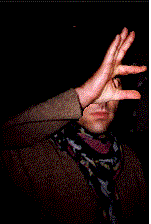
In my performances the story is rather absent, since narration belongs to theatre; I wish to stimulate associations which will forge different histories. It is nice if the presented image remains in spectator's mind, leaves an impression. I want to symbolize my existence, my presence, and for this reason I call into consciousness certain images from the past.

A reference to film and film procedures is always present with me. I make a sculpture and it presents -- to make an analogy with film -- the material which had been shot; then comes editing -- the problem of emplacement of sculptures; etc. And when spectators move around the place, their looks are movements of a camera -- this was my intention when leading a spectator through the space.

The mirror is said to be the symbol of symbolics, the instrument of psyche and of fear of self-anticipation. The mirror constantly reminds us of our presence, vanity, and transitiveness. It is our double, for representation is the double of death. Each time we look into the mirror we are older. This relates to the symbolic level. Besides, the mirror enables us to see two planes, two images from one point of view, by merely adjusting the focus: when we focus on the mirror, we see the mirror itself, and its proximity; but when -- without changing position -- we focus on the other plane, we see also the object, the image in the mirror, something outside the visual field. It is exactly this capacity of the mirror -- the dramaturgy of looking, the increased attention, suspension -- that has led me to start constructing such systems.
(Artist's statement)

I direct the movement of spectators with the installation; I wish to suggest positions and points of looking. I stimulate them to take the path which I believe is ideal. I lead them from room to room so that they experience all positions, all anxieties and feelings of being captured when they see themselves in the mirror. This is the issue that interests me: to make them face their own image: someone is looking at them, but actually it is them themselves; to shock and surprise them. The suspense.

At a classical exhibition, the point of looking is always the spectator, and the looked-at object is returning the look. However, reflective materials -- mirrors, in my case -- capture the space, and thus the spectators themselves. I let them know that they stand in the space -- that they are not the central point, the onlookers, voyeurs, but that in fact they are being looked at.
 Barbara Borcic
Barbara Borcic
 Marko A. Kovacic
Marko A. Kovacic